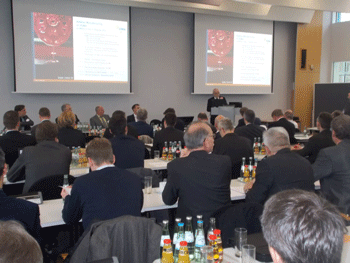VDMA reports successful meeting of its Additive Manufacturing Association
December 8, 2015
The Additive Manufacturing Association within Germany’s VDMA (Verband Deutscher Maschinen und Anlagenbau/ German Engineering Federation) recently held an information session at its headquarters in Frankfurt, Germany, where around 100 participants took the opportunity to hear first-hand experiences of Additive Manufacturing in the aviation and electronics sectors. Participants also heard explanations on additive practice by service providers.
In his keynote speech, Airbus’ Jörg Sander explained how the technology’s potential has so far been massively underrated. Since he first came into contact with Additive Manufacturing technologies at the end of the 1990s, he stated that the technology has made huge progress and that this is only the beginning. “It’s only superficially about parts or process control. The real revolution will be in process and supply chains,” stated Sander.
During his presentation, Sander used titanium parts as an example. Referring to traditional, subtractive processing routes, “the lighter a part, the more expensive material will be removed,” stated Sander. However, when using lasers to melt titanium powder into precision parts by layer construction, this cost is reversed. It is not only material and tool costs which would be lowered, Sander added that in the future it can be expected that titanium mines themselves will process their ore into powder for Additive Manufacturing. “The value chain and the process as a whole will completely change. And titanium is only one material in many,” says Sander.
New materials and new processes require new certifications and standards. In addition, design engineers need to completely rethink parts, as these will no longer be cast or milled from solid material. According to Sander, it then follows that design and manufacturing will grow together. “This will create a need for integrated teams where specialists of both sectors will collaborate with material experts, buyers and sales representatives. After all, Additive Manufacturing will also change supply and sales channels,” he explains.
Ingo Unckelmann of Materialise provided specific examples of how new functions can be integrated into parts through Additive Manufacturing. Discussing the company’s software he gave an example of improving the cooling and heating effect of heat exchangers through a texturised surface or bionic light weight design. This, he stated, would transfer natural structures, optimised through millions of years of evolution, onto technical parts in quick motion. It is only additive technologies that allow for the production of highly complex bionic structures often marked by varying wall thickness and geometries, he said.
Materialise produces such components in 130 facilities of their own worldwide, and they are the leading supplier of process software. Among other things, this software checks designs for faults and corrects wherever necessary. It also supports design engineers in production planning, for example by automatically offering necessary supporting structures, or by converting light weight design structures into parts.
The members of the Additive Manufacturing Association within VDMA, comprising over 90, stated it was their priority not just to share information and education on AM technology but also to further technical development and standardisation. “We need to pool our strengths in order to quickly bring Additive Manufacturing to the industrial level,” stated Rainer Gebhardt, Project Manager of the Additive Manufacturing Association within VDMA. Many sectors could benefit from Additive Manufacturing’s technological and economical potentials. “If we don’t broaden these advantages, others will do it,” cautioned Gebhardt.

















